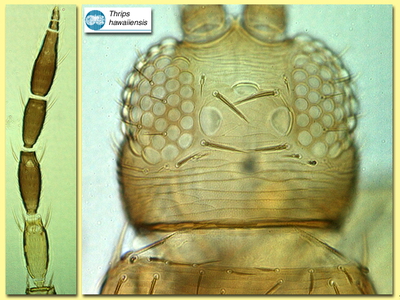Figures
Fig. 1 Antenna and head (dorsal)
Fig. 2 Head, thorax and abdomen
Fig. 3 Pronotum
Fig. 4 Meso- and metanotum
Fig. 5 Fore and hind wing
Fig. 6 Tergite and pleurotergites II and III
Fig. 7 Sternite VI and VII
Fig. 8 Tergite VIII
Species
Thrips hawaiiensis Morgan
Biology
A highly polyphagous flower-living species, causing damage to some plants but probably an important pollinator on banana and oil palm trees.
Distribution
Widespread across Asia and the Pacific to New Zealand, also northern Australia and southern U.S.A.Recognition
Medium sized thrips, commonly with abdomen brown but head and thorax paler; legs yellow, forewing brown with base pale; antennal segment III yellow, remaining segments brown. Antennae 7- or 8-segmented, III & IV with sense cone small and forked. Head with no setae in front of fore ocellus, one pair just outside anterior margins of ocellar triangle. Pronotum with 2 pairs of posteroangular setae. Metanotum with transverse lines of sculpture at anterior but elongate reticulation on posterior half; median setae at anterior margin. Forewing first vein with 3 setae on distal half. Tergite II with 4 lateral marginal setae; V-VIII with ctenidia laterally, on VIII posteromesad of spiracle; posteromarginal comb on tergite VIII short and irregular. Sternites with a median row of about 15 discal setae; pleurotergites without discal setae.
Related species
This is a member of a complex of species that are not easy to distinguish from each other (Palmer, 1992), including particularly T. florum. Despite the number of morphological segregates that have been named as distinct species, these have rarely been substantiated by any biological or host plant differences. One distinctly bicoloured form seems to be associated commonly with bananas.









